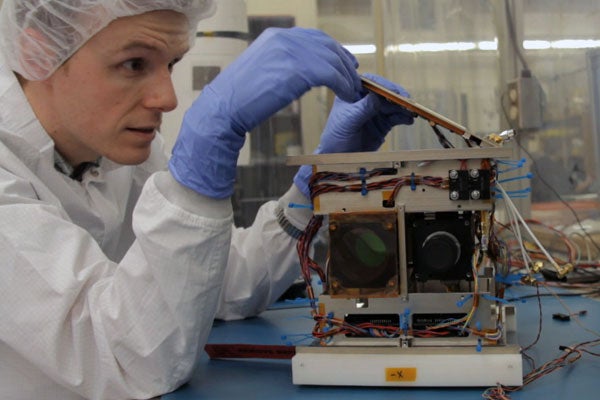
Toaster-sized space telescope launches from India
Published: February 25, 2013
The smallest astronomical satellite ever built launched Feb. 25, 2013 as part of a mission to prove that even a very small telescope can push the boundaries of astronomy.
The satellite was designed and assembled at the Space Flight Laboratory of the University of Toronto Institute for Aerospace Studies (UTIAS). It was launched from the Satish Dhawan Space Centre in Sriharikota, India, along with its twin, also designed in Canada, but assembled in Austria.
"The launch appeared to go flawlessly," said Cordell Grant, manager of satellite systems for the UTIAS lab. "It was nerve-wracking watching the launch because something can always go wrong. I felt great when it launched successfully and I felt even better a few hours later when we actually 'talked' to the satellites and ensured they were both working."
Each nano-satellite in the mission, which is known as BRITE, is a cube 20 centimetres per side that weighs less than 7 kilograms. The BRITE satellites are part of the new wave of nano-satellites that can be designed, assembled and deployed fast and relatively cheaply.
“The Space Flight Laboratory has demonstrated that nano-satellites can be developed quickly, by a small team and at a cost that is within reach of many universities, small companies and other organizations,” Grant said. "A nano-satellite can take anywhere from six months to a few years to develop and test, but we typically aim for two years or less."
Up to now, such nano-satellites had been used only to monitor the earth and experiment with new technologies.
“Researchers, scientists and companies worldwide, who have great ideas for space-borne experiments, but do not have the means to fund a large spacecraft, can now see their ideas realized,” said Grant. “BRITE has the potential to open an entirely new market for low-cost high-performance satellites.”
BRITE is the first nano-satellite mission intended for astronomy, and the first-ever astronomy constellation —more than one satellite working toward a common objective— of any size. The previous world-record holder for small astronomy satellites was also designed and assembled in part by U of T. Known as MOST, it launched in 2003 and was the first entirely Canadian satellite for astronomy, weighing in at 53 kilograms. Compared to the 11 metric tons of the Hubble Space Telescope, MOST was aptly called a micro-satellite. It is still operating today.
“BRITE is expected to demonstrate that nano-satellites are now capable of performance that was once thought impossible for such small spacecraft,” said Grant.
BRITE is not intended to take pictures, Grant said, but will simply observe stars and record changes in their brightness over time. Such changes could be caused by spots on the star, a planet or other star orbiting the star, or by oscillations and reverberations within the star itself —like earthquakes on Earth.
To perform precise measurements of the brightness of stars, the telescopes need to be above the atmosphere. Otherwise, scintillation —the atmospheric effect that causes stars to twinkle— overwhelms the relatively small brightness variations of the stars themselves. By avoiding this, a very small telescope in space can produce more accurate data than a much larger telescope on the ground.
Also, unlike telescopes on Earth which are useless during the day, in bad weather or when the stars set below the horizon, telescopes in space can potentially observe stars all the time.
"As their name suggests, the BRITE satellites will focus on the brightest stars in the sky including those that make up prominent constellations like Orion the Hunter," said Grant. "These stars are the same ones visible to the naked eye, even from city centres."
Because very large telescopes mostly observe very faint objects, the brightest stars are also some of the most poorly studied stars, he said. But the brightest stars are also the largest.
"Big, bright stars lead short and violent lives and deaths (supernovas) and in the process seed the universe with heavy elements without which life on Earth would be impossible," Grant said. "To better understand these stars is to better understand how life arose on our planet."
Because big objects oscillate and quake slower than smaller ones, the BRITE satellites do not have to keep their eyes constantly on any given star, but can observe from time to time to see if anything has changed.
"The BRITE satellites can monitor their target stars whatever orbit they are placed on, and don't require a dedicated rocket to place them in a specific orbit," Grant said. "By piggy-backing on any available rocket, the BRITE satellites can thus be launched for relatively little money.
To gather more observations and to increase the lifetime of the mission, scientists will be launching three such pairs of satellites —one Austrian pair, one Polish pair and one Canadian pair supported by the Canadian Space Agency— so that within a few years BRITE will become a constellation of six satellites. Each twin in a pair watches the sky in a different colour (red or blue), providing another exciting layer of data to the scientists.



